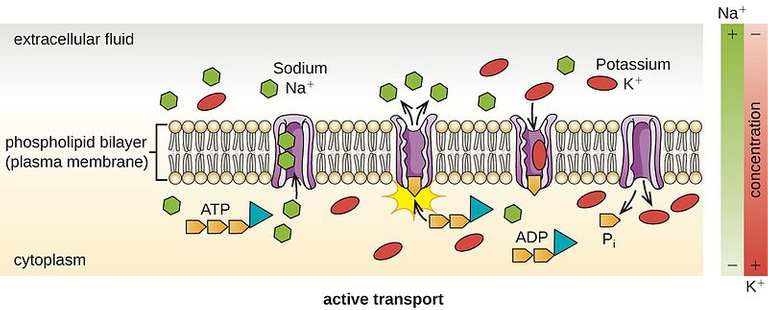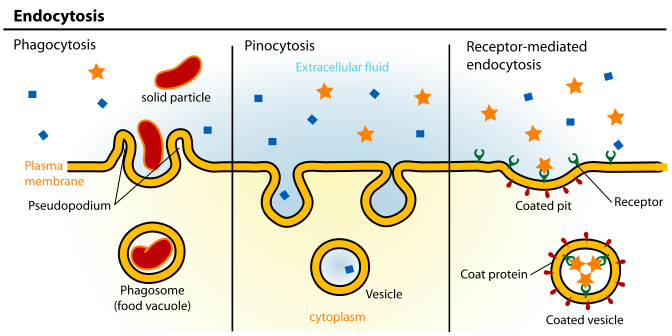Movement across cell membrane/ Active transport- part two

Diagram showing active transport, credit: wikipedia
The cell does not use any energy during any of the transport processes that were discussed in my previous article. Membrane proteins that function in a manner analogous to passive transport of molecules do so independently of ATP. To transfer a material across a membrane with the assistance of membrane protein and against the direction of its concentration gradient, primary active transport necessitates the utilization of ATP.
Proteins that function as pumps are involved in one of the most widespread forms of active transport. When you hear the term "pump," you probably immediately think of applying some kind of force to pump up the tire of a bicycle or a basketball. Similarly, the energy provided by ATP is necessary for these membrane proteins in order for them to transport substances, whether molecules or ions, across the membrane, against the concentration gradients of those substances (from an area of low concentration to an area of high concentration).
The Na+/K+ ATPase, commonly known as the sodium-potassium pump, transfers potassium into cells while removing sodium from them. One of the most significant types of ion pump, the Na+/K+ pump may be found in the membranes of all types of cells. Because of the high level of activity that it generates, these pumps in nerve cells are responsible for the vast majority of the ATP that is used by those cells.
To transfer chemicals across the membrane, active transport pumps can potentially collaborate with other active or passive transport mechanisms. For instance, the sodium-potassium pump ensures that the extracellular environment has a high concentration of sodium ions at all times. Consequently, if the cell wants sodium ions, all it needs to do is open a passive sodium channel, and the concentration gradient of the sodium ions will cause them to diffuse into the cell. This is the only thing the cell needs to do in order to obtain the sodium ions it needs. With this mechanism, the operation of an active transport pump, known as the sodium-potassium pump, generates a concentration gradient, which in turn fuels the transport of sodium ions in a passive fashion. It is referred to as secondary active transport when active transport is used to power the transportation of another material in this manner.
The movement of two substances in the same direction is carried out by symporters, which are secondary active transporters. For instance, the sodium-glucose symporter employs the "pulling" force of sodium ions so that glucose molecules may enter the cell. Since cells store glucose for energy, glucose is normally at a higher concentration inside the cell than outside; nonetheless, when the symporter is activated, sodium ions will easily flow into the cell due to the activity of the sodium-potassium pump. The energy that is provided by the influx of sodium ions through the symporter is what makes it possible for glucose to flow through the symporter and into the cell, despite the fact that there is a concentration gradient.
On the other hand, antiporters are active systems that move substances in the opposite direction. The sodium-hydrogen ion antiporter, for example, harnesses the energy from the inward stream of sodium ions to transport hydrogen ions (H+) out of the cell. The sodium-hydrogen antiporter is what's responsible for keeping the pH of the cell's interior at the appropriate level.
Additional Membrane Transfer Methods
Membrane carriers are not used in other types of active transport. Endocytosis, sometimes known as "bringing into the cell," is the process by which a cell ingests material by encasing it in a part of its cell membrane and subsequently severing that membrane. An independent, intracellular vesicle is formed when a part of the membrane and its contents are pinched off. A membranous sac called a vesicle is a hollow, spherical organelle surrounded by a membrane made of lipid bilayers. Materials that need to be digested or broken down are frequently brought into the cell through endocytosis.

Endocytosis, credit: wikipedia
Large particles are endocytosed during phagocytosis, often known as "cell eating." A large number of immune cells phagocytose invasive microorganisms. Their duty is to patrol bodily tissues for undesirable material, such as bacterial cells that have invaded, phagocytize, and digest it. They resemble small Pac-men. Pinocytosis, sometimes known as "cell drinking," is the process of bringing fluid containing dissolved chemicals into a cell through membrane vesicles as opposed to phagocytosis.
In general, phagocytosis and pinocytosis are not very discriminating in the things they carry into the cell, although they do take in enormous amounts of extracellular material. Receptor-mediated endocytosis is a mechanism by which cells control the endocytosis of particular molecules. Receptor-mediated endocytosis is the endocytosis of a region of the cell membrane that has several receptors tailored to a particular chemical.
The portion of the cell membrane holding the receptor-ligand complexes will be endocytosed after the surface receptors have bound sufficient quantities of the particular substance (the receptor's ligand). Red blood cells achieve this by endocytosing iron, which is necessary for the formation of hemoglobin. In the blood, iron is bonded to a protein referred to as transferrin. Iron-transferrin molecules attach to specific transferrin receptors on the surface of red blood cells, and the cell then endocytoses the receptor-ligand complexes.
Exocytosis, which literally means "taking out of the cell," is the process by which a cell exports material utilizing vesicular transport. Similar to a business producing goods for export, several cells produce compounds that must be released. Throughout the cell, these chemicals are normally contained in vesicles that are membrane-bound. The vesicle ruptures into the interstitial fluid as soon as the vesicle membrane unites with the cell membrane. The vesicle membrane subsequently fuses with the cell membrane.
Exocytosis may be seen in action in the cells of the stomach and pancreas, which produce and secrete digestive enzymes. Exocytosis can also be seen in the cells of the endocrine glands, which produce and secrete hormones that are distributed throughout the body.
Endocytosis is typically paired with the insertion of new membrane to the plasma membrane to prevent the cell from continually expanding. The cell membrane undergoes continuous renewal and modification as required by the cell through various mechanisms.
Referrences
- Mattaini, K. (n.d.). Chapter 8. Membrane Transport – Introduction to Molecular and Cell Biology. Chapter 8. Membrane Transport – Introduction to Molecular and Cell Biology. https://rwu.pressbooks.pub/bio103/chapter/membrane-transport/
- Biga, L. M., Dawson, S., Harwell, A., Hopkins, R., Kaufmann, J., LeMaster, M., Matern, P., Morrison-Graham, K., Quick, D., & Runyeon, J. (n.d.). 3.1 The Cell Membrane – Anatomy & Physiology. 3.1 the Cell Membrane – Anatomy & Physiology. https://open.oregonstate.education/aandp/chapter/3-1-the-cell-membrane/
- Cell - Transport across the membrane. (n.d.). Encyclopedia Britannica. https://www.britannica.com/science/cell-biology
- Membrane Transport. (2013, October 2). Chemistry LibreTexts. https://chem.libretexts.org/Bookshelves/Biological_Chemistry/Supplemental_Modules_(Biological_Chemistry)/Proteins/Case_Studies%3A_Proteins/Membrane_Transport
- Stillwell, W. (2016, July 15). Membrane Transport. PubMed Central (PMC). https://doi.org/10.1016/B978-0-444-63772-7.00019-1


Thanks for your contribution to the STEMsocial community. Feel free to join us on discord to get to know the rest of us!
Please consider delegating to the @stemsocial account (85% of the curation rewards are returned).
You may also include @stemsocial as a beneficiary of the rewards of this post to get a stronger support.